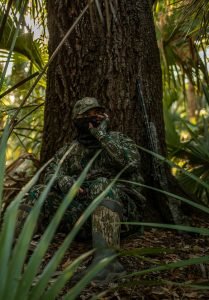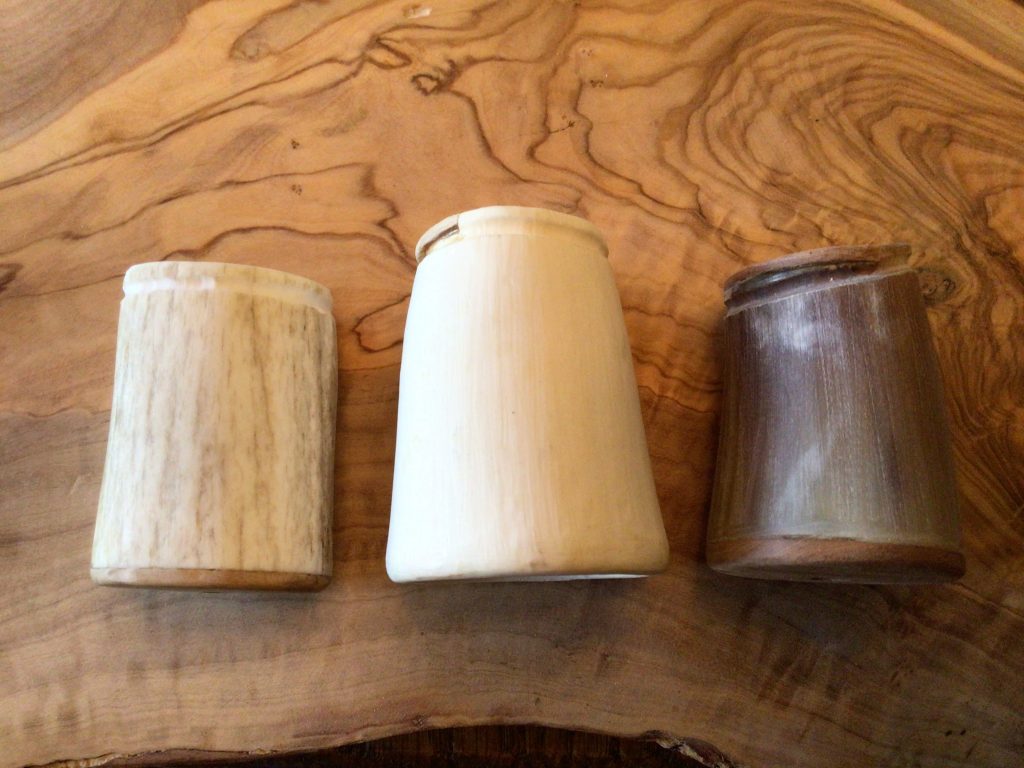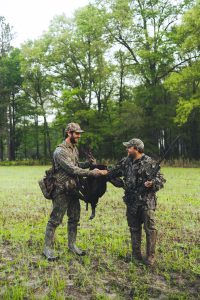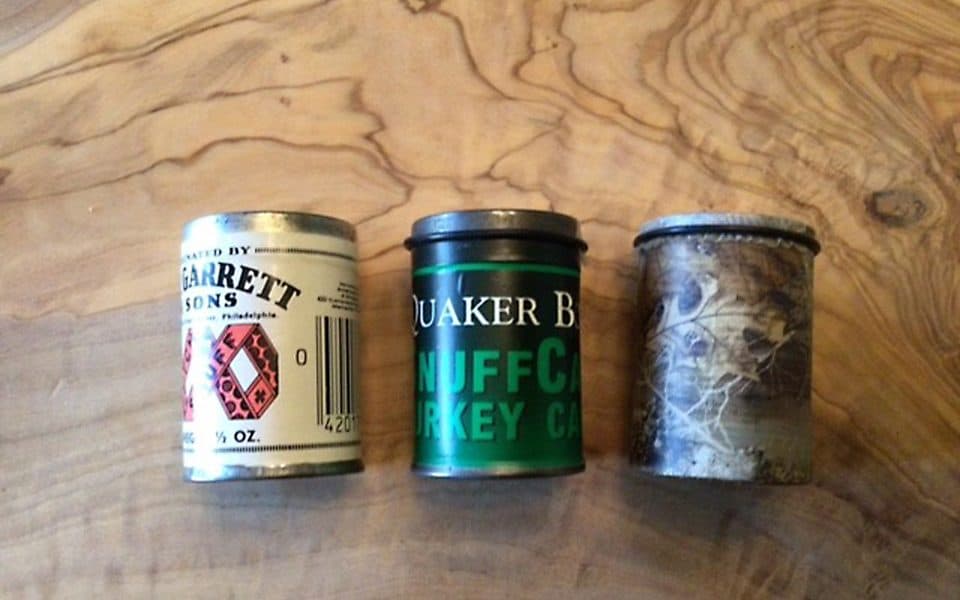Fifty years is a long time to postpone creating and sharing a “how-to” with others. I have a decades-old folder of just such articles, including some on all types of turkey calls. One of the simplest of these is a tube-type call. I have read numerous articles on them, but never one that, with clarity, explained how to accurately produce with these little calls the various sounds turkeys make. But first, I want to delve into the history and use of these calls, as well as how to make them.
The history of tube calls is fuzzy at best. I haven’t found any information on them prior to those made with half-ounce snuff cans, which will be the focus of this first article. Various sources date the first ones back to the Appalachian Mountains in the mid-1800s. I have not been able to get the history of the half-ounce snuff can itself. Some sources say it may have been first produced between 1861 and 1865 – the period known as the first industrial revolution. Others speculate it may have been around 1900 after the American Tobacco Company moved to Memphis and changed its name to Memphis Snuff Company.
 Back in 2006, I was told by a store owner in Camden, Alabama (my source of these cans) that his sales rep had advised him that the Memphis Snuff Company was changing the half ounce can to a compressed paper container. No more snuff can turkey calls! I was able to contact their purchasing agent in Memphis to get the facts. He told me that they were in need of additional floor space in the plant, and the can-making contraption, which dated back to the Industrial Revolution, took up a great deal of floor space; thus the switch. I was then able to procure 300 empty, unlabeled cans from their last run in exchange for five calls made from their cans, a deal for which I will be forever grateful.
Back in 2006, I was told by a store owner in Camden, Alabama (my source of these cans) that his sales rep had advised him that the Memphis Snuff Company was changing the half ounce can to a compressed paper container. No more snuff can turkey calls! I was able to contact their purchasing agent in Memphis to get the facts. He told me that they were in need of additional floor space in the plant, and the can-making contraption, which dated back to the Industrial Revolution, took up a great deal of floor space; thus the switch. I was then able to procure 300 empty, unlabeled cans from their last run in exchange for five calls made from their cans, a deal for which I will be forever grateful.
With these speculations in mind, I am going to postulate that the creation of three things came together in either the mid to late 1800s or early 1900s, and resulted in the first snuff can call. These were: 1) the snuff can; 2) latex balloons (created in 1847); and 3) adhesive tape (created in 1845). The can-making machine may have been created around 1851.
In the earlier pioneer days, turkey hunters would have known about the Indians’ ways of calling turkeys, which included using their own vocal cords as well as blowing air across a leaf held between the thumbs. Even today, there are still a few old-school hunters who are successful with these two methods.
In the mid-1970s, Dick Kirby founded Quaker Boy Calls. One of their calls was made from the Memphis Snuff Company half-ounce cans to make their commercially produced snuff can turkey calls. (I am fortunate to have one, and its green logo paper label is still in excellent shape.) Their call had a ¾” hole in the bottom, the half-moon cutout was made in the lid, and the latex was placed over the half-moon void in the lid and held in place by sliding the lid down over it. Ten years later, Mossy Oak was founded by Toxey Haas, and the two companies developed a strong bond, held together by their love for turkey hunting.
Several T.V hunting show personalities have been seen using tube type calls, though I don’t know if any were the original snuff cans. These include Will Primos, Cuz Strickland, Harold Knight, and Michael Waddell.
Over the years since 2006, I have given away and sold about 225 calls made from the snuff cans, so there are still a few out there. It was the pending extinction of the little metal can that motivated me to try and create some substitutes. In my 50 years of experience and trial-and-error testing with tube calls, I am convinced that this type of call best mimics the numerous sounds that turkeys make. The hurdle seems to be confusing, incomplete instructions. I hope to eliminate that hurdle with the instructions to follow.
Making your Own Tube Call
My maternal grandmother often reminded me that my first words were, “Do it self!” whenever someone tried to show me how or help me do something. I sadly admit, that it carried over to adulthood, sometimes out of necessity, and it probably will not end until I move into a nursing home.
Back in 1973 when I moved from Mobile to Wilcox County in Alabama – known as a turkey hunting heaven – I discovered that my neighbor, Gene Handly, was not only a great turkey hunter, he was also a championship caller – and a practitioner of the snuff can call! He quickly became my mentor. He had picked up the art from William Harris, who owned a country store down the road. Mr. Harris was well-known for his paintings of turkeys, as well as rustic scenes from “back in the day,” most framed in genuine barn wood.

Somewhere along the way, Mr. Harris had changed the way snuff cans were transformed into turkey calls compared to the Quaker Boy method. He inverted the can and punched two thin slices in the lid with a pocket knife, forming a “V” in the center of the lid. He then cut the half-moon hole in the top (previously the bottom) with a knife by first scribing a straight cut-line across the halfway mark of the can bottom. After cutting around the edge of one half of the can to the ends of the scribe, it leaves a jagged half-moon piece. This is removed by placing one thumb inside the can against the underside of the scribe line, and pushing down on the cut piece with a finger from the other hand. By working the half-moon piece back and forth to the inside, it will soon break off, leaving a smooth edge on the outside edge where it contacts the lip.
When Duct Tape started being produced with camo patterns, I began covering my cans with it. I also spray-painted the lid (now the bottom of the call) with a flat, grainy, brown spray paint. It looks like dirt and totally eliminates glare. When applying the tape, start just below the top lip at the latex end to leave room for the O-ring that holds the latex in place. Trim the excess tape off the bottom with knife or scissors.
To really boost the sound volume, cut the camo tape around the can at the edge of the lid with a razor blade or sharp knife, making the lid removable. Taking the lid off will give the call maximum volume, and it is really loud! For finer adjustments, remove the lid and press the “V” inward to be louder and nearer to closing it for softer tones, and place it back on the call. Low tech at its best! On my calls, I also changed from the “V” cut to a bored ¼” hole and I change volume by changing the force of the air going between latex and lip.
When I discovered in 2006 that the cans were about to be history, I started to experiment with other materials. The obvious ones were those that were already hollow – bamboo, bone, cow horn, brass or copper tubing, PVC, 35mm film tube, and plastic pill bottles. Getting sucked into this “hobby” soon turned into a passion. I built a little 12’x12’ shop, bought the necessary tools and commenced making calls out of correctly sized saplings of various species cut in the winter to reduce dry cracking. I then commenced to the world of exotic, beautifully figured hardwoods, of which there is no end.
To back up a moment, back in the 1980s I started another hobby – drawing turkeys – that evolved into painting turkeys. With the success of the lathed, highly figured calls, I pulled the two “hobbies” together and began painting a turkey bust on each exotic wood call. They proved to be quite popular as gifts and contributions to fund raisers – county NWTF auctions, fund raising auctions for needy families, etc. This has been far more rewarding than simply selling them.
Looking now at my experiences making calls from other materials, for starters, size does matter. After years of experimenting, it became obvious that for hen sounds, the diameter and length of the snuff can was very important in achieving the proper pitch and tone, and those of the snuff can were dead-on for hen sounds. I test my calls by comparing their sound to that of the wild turkey sound recordings on the NWTF web site. I firmly believe the tube call comes closer to simulating the real turkey sounds than any other type of call.
To make a wooden call for hen sounds, the wood blank should be thick enough to accommodate a 1” to 1-1/16” diameter hole, while leaving a wall about 1/8” thick. When coring the wood, leave a base 1/8” thick and bore a 1/4” hole in the center of the base. You can also glue on a 1/8” thick base and rasp or sand the edge to align with the tube. The height of the call should be from 1-3/4” to 2”. The most accurate hen sounds are made using .002 latex, also known as prophylactic latex. Open-bottom gobble/cutting tube calls use .006 latex for a deeper tone.
The gobble/cutter tube cavity at the top should be 1-1/8” to 1-1/4” diameter, requiring a little thicker tube, and height can be from 2” to 2.5” – slightly longer than the hen call. The bottom inside diameter can be from the same as the top or even wider, since it is completely open. Both hen and gobbler wooden calls require a half-moon baffle in the top, counter sunk by trimming 1/8” off half the top on the side where it will be glued. This forces all the air and sound out the bottom and prevents a “muffling” of the sound. For those who want to make their own tube calls, I recommend starting with materials that are already hollow – bamboo, 35mm film tubes, small plastic Tylenol bottles, PVC tubing, etc. There is little to no expense with these, no shop equipment required, and very little expense for glue and latex.
Getting the Sound Correct
 You will discover how easy it is to mimic every sound hens and gobblers make by using a method called “phonics.” First, the definition of phonics: “Matching the sounds of spoken English with letters or groups of letters.” For the purposes of this article, we will alter this definition to read as follows: “Matching sounds that turkeys make with English letters or groups of letters.” In short, you are about to learn how to talk turkey.
You will discover how easy it is to mimic every sound hens and gobblers make by using a method called “phonics.” First, the definition of phonics: “Matching the sounds of spoken English with letters or groups of letters.” For the purposes of this article, we will alter this definition to read as follows: “Matching sounds that turkeys make with English letters or groups of letters.” In short, you are about to learn how to talk turkey.
We will use the letters C, P, and T, as well as some combinations of letters and non-letter sounds. Reminder: all tube call turkey sounds are made by forcing air between the lip and the latex, and lips and latex must be moistened with the tongue. It’s how we originate and release the air (phonics) that creates the desired sounds.
We begin with the “cluck,” which can be produced two ways. Using a hen call (baffled), hold the call with the latex to the top, press your bottom lip against the latex, and your top lip over the edge of the call. Pull your tongue back in your mouth to create more air space, shape your tongue against the back floor of your mouth as though to say the letter “P”, and thrust your tongue forward, forcing air between the bottom lip and the latex. Presto – a cluck! You will quickly see how easy it is to control the volume by changing the force of the air. This sound is best used in conjunction with early morning tree yelps.
For louder yelps, we will use the letter “T”. With lips in the same position as above, press your tongue against the roof of your mouth as you would to say the letter “T”. Rapidly release a gentle (to begin with) burst of air as though you are saying “tuck.” The K at the end cuts off the sound in the throat, allowing you to repeat the call. The more air, the louder the cluck; just be sure you are not making a loud alarm putt.
While using the tongue, we will move on to a “purr.” Still using the letter “T”, place the tip of your tongue against the roof of your mouth just behind your front teeth, as though to say “T”. Release air from the throat gently, causing the air to exit between the tongue and roof of your mouth – called “trilling” – creating the purr that turkeys make.
To make that all-important “yelp,” we will use the letter “C” – specifically, a hard “C”, as in saying, “cook.” The “k” at the end serves to cut off the yelp and go right into the next one. Hold the call in the same position as the previous ones – latex to top. Prepare as if to say “cook.” Release and stop air from the throat in short bursts and behold – a series of yelps! Pressing the bottom slightly tighter against the latex raises the pitch higher. When you have mastered the cluck, purr, and yelp, it is easy to roll these three sounds into one continuous call: a few clucks followed immediately by purrs, followed by yelps.
To make a young turkey’s kee-kee, prepare your tongue as though to say, “coo, kee, kee, kee, kee”, using more air volume than the yelp. After the initial “coo”, put more pressure on the latex with the top lip. These are generally used in a sequence of one “coo,” followed by three to five “kees.”
We now move to the gobble/cutter tube with the open end. This call has a slightly larger internal diameter and length, producing a lower pitch. For the gobble, we will use the letter “T” as well as a sound of “Kuh.” Rotate the call, turning the latex to the bottom and using the top lip against the latex, and seal the call with the bottom lip on the base of the call. The gobble sound is somewhat similar to a mallard duck feeding call. Prepare by taking a deep breath, press the top lip against the latex, and blast out air as though to rapidly say, “tookuh, tookuh, tookuh, tookuh.” When you get this one perfected, it works great against dominate gobblers. He comes looking for a fight to protect his harem.
Summery
Before making and/or practicing these “phonics” lessons, I strongly suggest that you find the NWTF web site and listen to the recordings of real turkeys. The South Carolina NWTF also has an excellent recording of all these sounds. Save it to your favorites and use it often. I like to practice one sound at the time and perfect it before moving to another. Your diligence will be rewarded by many successful hunts and many good stories.





